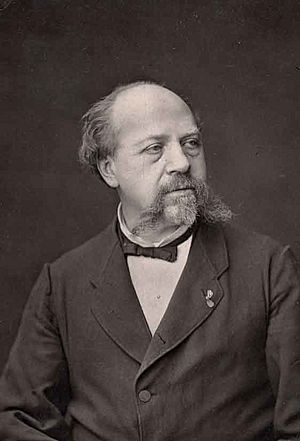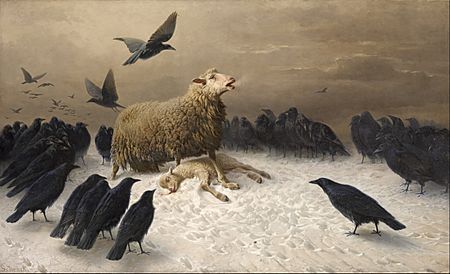August Friedrich Schenck facts for kids
Quick facts for kids
August Friedrich Schenck
|
|
|---|---|
 |
|
| Born | 23 April 1828 Glückstadt |
| Died | 1 January 1901 Écouen |
| Occupation | Painter |
| Style | landscape painting |
| Spouse(s) | Ludowika Stapaczinska |
August Friedrich Albrecht Schenck (born April 23, 1828 – died January 1, 1901) was a famous painter. He was born in Glückstadt, which is now part of Germany. At that time, it was part of Denmark.
Schenck spent most of his life living and working in France. He was considered to have both French and German nationality.

Schenck learned to paint from Léon Cogniet in France. He became very well known for his beautiful landscapes and paintings of animals. His artwork was first shown to the public in 1855.
His most famous painting is probably Anguish. It is an oil painting that shows a mother sheep grieving over her dead lamb. Dark, scary-looking crows are circling around them. The National Gallery of Victoria in Melbourne, Australia, bought this painting in 1880.
In 1885, Schenck was honored with the title of knight of the Legion of Honour. This is a very important award in France. He passed away in Écouen, a town near Paris.
Contents
August Schenck's Life Story
When August Schenck was a young man, he left his hometown of Glückstadt. He wanted to earn a good living as a "wine traveler." This job involved traveling to sell wine in different countries. He worked in Germany, Russia, and then Portugal.
After five years, he left Portugal and moved to Paris, France. There, he began his training to become a painter. He studied with Léon Cogniet (1794-1880). Cogniet was a professor at a famous art school called the École des Beaux-Arts. After his training, Schenck decided to live in France permanently.
Becoming a Famous Animal Painter
Schenck was 27 years old when his paintings were first shown to the public. This happened at the World Exhibition in Paris in 1855. In 1857, he also showed his art at an exhibition in Schleswig-Holstein.
After this, he had a very successful time creating art. He became especially famous for his paintings of animals. Schenck and a French painter named Rosa Bonheur (1822–1899) were two of the most popular animal painters of their time. People from all over the world wanted to collect their artwork.
Life in Écouen
Around 1862, Schenck and his wife, Ludowika Stapaczinska, moved to Écouen. Ludowika was born in Warsaw. Écouen is a town about 20 kilometers (12 miles) north of Paris.
Écouen was known as a place where many artists lived and worked. This artist community was called the École d’Écouen. Famous artists like Charles-François Daubigny, Jean-Baptiste-Camille Corot, and Mary Cassatt also spent time there.
Even today, you can find reminders of Schenck in Écouen. In 1906, a street where his house and studio were located was renamed Rue Auguste Schenck to honor him. Two of his paintings are also in the town:
- L’Échir hangs in the town hall.
- Lamb of God - Agnus dei is in the local church.
His Artwork in Museums
During his lifetime, August Schenck was well-known across France. Major museums began to buy his paintings. Since then, museums around the world have acquired his artwork.
One of his paintings, called "Lost," shows a group of sheep with two dogs. In the front of the painting, the sheep are huddled together during a snowstorm. In the background, there is a monument with a cross, which adds a religious feeling to the scene. This painting is now displayed at the Metropolitan Museum of Art in Manhattan, New York City.
August Schenck passed away on January 1, 1901. He is buried in Écouen, the town where he lived for many years. The street named after him, rue Auguste Schenck, still exists there today.
See also
 In Spanish: August Friedrich Schenck para niños
In Spanish: August Friedrich Schenck para niños

